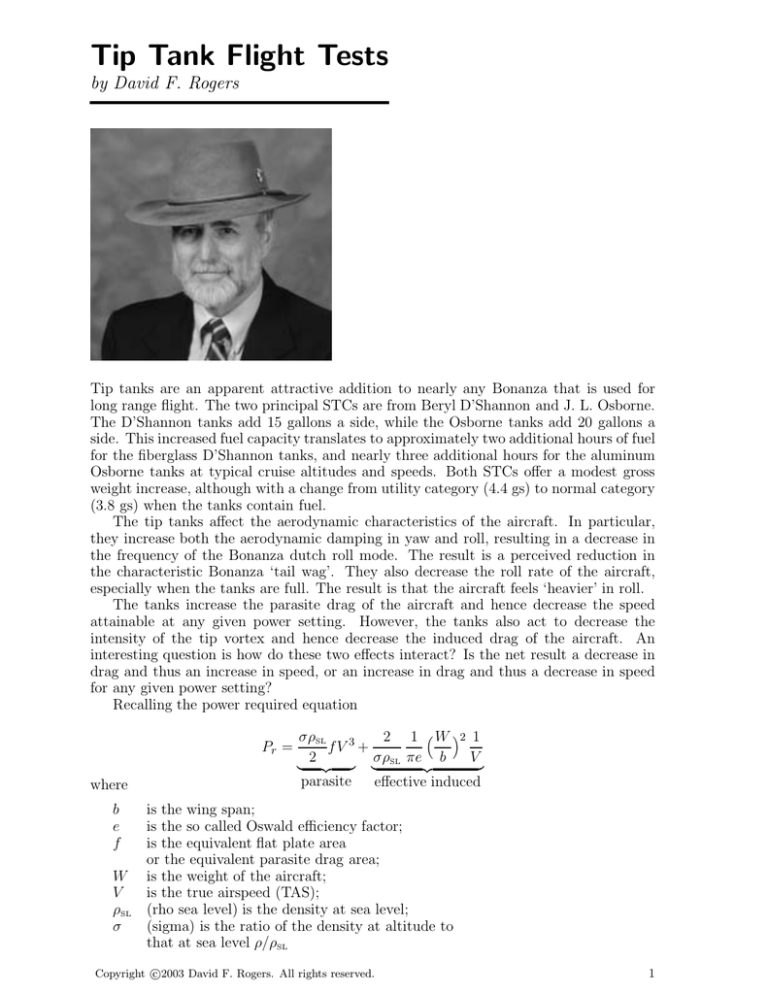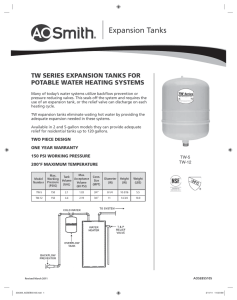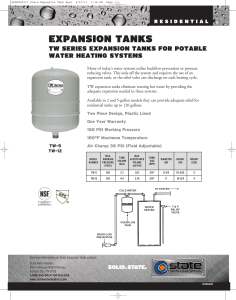
Tip Tank Flight Tests
by David F. Rogers
Tip tanks are an apparent attractive addition to nearly any Bonanza that is used for
long range flight. The two principal STCs are from Beryl D’Shannon and J. L. Osborne.
The D’Shannon tanks add 15 gallons a side, while the Osborne tanks add 20 gallons a
side. This increased fuel capacity translates to approximately two additional hours of fuel
for the fiberglass D’Shannon tanks, and nearly three additional hours for the aluminum
Osborne tanks at typical cruise altitudes and speeds. Both STCs offer a modest gross
weight increase, although with a change from utility category (4.4 gs) to normal category
(3.8 gs) when the tanks contain fuel.
The tip tanks affect the aerodynamic characteristics of the aircraft. In particular,
they increase both the aerodynamic damping in yaw and roll, resulting in a decrease in
the frequency of the Bonanza dutch roll mode. The result is a perceived reduction in
the characteristic Bonanza ‘tail wag’. They also decrease the roll rate of the aircraft,
especially when the tanks are full. The result is that the aircraft feels ‘heavier’ in roll.
The tanks increase the parasite drag of the aircraft and hence decrease the speed
attainable at any given power setting. However, the tanks also act to decrease the
intensity of the tip vortex and hence decrease the induced drag of the aircraft. An
interesting question is how do these two effects interact? Is the net result a decrease in
drag and thus an increase in speed, or an increase in drag and thus a decrease in speed
for any given power setting?
Recalling the power required equation
Pr =
2 1 W 2 1
σρSL
fV 3 +
2
σρSL πe b
V
where
b
e
f
W
V
ρSL
σ
parasite
effective induced
is the wing span;
is the so called Oswald efficiency factor;
is the equivalent flat plate area
or the equivalent parasite drag area;
is the weight of the aircraft;
is the true airspeed (TAS);
(rho sea level) is the density at sea level;
(sigma) is the ratio of the density at altitude to
that at sea level ρ/ρSL
c
Copyright 2003
David F. Rogers. All rights reserved.
1
or simplifying to
1 1 2 1
e b V
parasite
effective induced
where Const and Konst are constants, we can anticipate the results. Specifically, note
that the first term in the equation, the parasite power required, involves the equivalent
parasite drag area, f, and is proportional to the cube of the true airspeed, V . Because
f increases when tip tanks are added we expect that adding tip tanks will decrease the
true airspeed at high cruise airspeeds and power settings.
However, the second term, the effective induced power required, involves the Oswald
efficiency factor, e. The Oswald efficiency factor is increased by the effect of the tip
tanks. The induced drag is also decreased. Hence, the effective induced power required
is reduced. Because the effective induced power required is inversely proportional to the
velocity, it is most important at low true airspeeds which correspond to high wing lift
coefficients and high induced drag. Notice that this term is also inversely proportional
to the wing span, b. If the tip tanks increase the effective wing span, then the effective
induced power required is reduced.
If the increase in parasite power required occurs at high true airspeed while the
decrease in effective induced power required occurs at low true airspeed, then there must
be some true airspeed at which the effects are equal and cancel each other. Typically, an
aircraft designer wants that true airspeed to be the design cruise true airspeed.
To answer this question, comparative flight tests were carried out on two model E33A
Bonanzas – N7960R (CE-270) and N2255A (CE-280). Both aircraft have essentially the
same empty weight at 2151 lbs for N7960R and 2142 lbs for N2255A, including the weight
of six gallons of unusable fuel and ten quarts of oil. N7960R is equipped with Beryl
D’Shannon tip tanks; N2255A is not. Both aircraft had recently overhauled McCauley
3-blade propellers. Both aircraft had approximately 100 hours on recently installed IO520BB factory remanufactured engines.
The flight tests were conducted at a pressure altitude of 6000 feet. The horseshoe
heading technique † was used to determine the true airspeed from GPS ground speed
at brake horsepower settings from 42.5% to 75% for N2255A and from 44% to 74.5%
for N7960R. A stroboscopic Proptach was used to measure propeller RPM, and the
aircraft instrument was used to measure manifold pressure in order to determine power
available. Mixture was set to correspond to best power, i.e., approximately 100◦ rich
of peak. Takeoff weight was 2952 lbs for N7960R and 3209 lbs for N2255A. During the
flight tests, weight varied from 2960 lbs to 2897 lbs for N7960R and from 3186 lbs to
3097 lbs for N2255A. Outside air temperature (OAT) varied from 59◦ F to 62◦ F for the
N7960R flights, with most flights occuring with an OAT of 62◦ F; for N2255A the OAT
was constant at 33◦ F. Manifold pressure varied from approximately 19 Hg to 23 Hg in
1 Hg increments, while propeller speed varied from approximately 2000 to 2500 RPM in
100 RPM increments. The results of these flight tests are shown in Figure 1. No weight
or temperature corrections have been applied to the TAS data.
Pr = Const fV 3 + Konst
† http://www.nar-associates.com/technical-flying/
horseshoe heading/horseshoehead.pdf
c
Copyright 2003
David F. Rogers. All rights reserved.
2
Per Cent Brake Horsepower Available
80.0
75.0
70.0
65.0
60.0
Pressure altitude = 6000 ft
N2255A E33A CE-280 Bonanza
Weight 3186 - 3097 lbs
OAT = 33o F
N7960R E33A CE-270 Bonanza
Weight 2960 - 2897 lbs
OAT = 62o F
Tip tanks empty
55.0
N2255A without tip tanks
50.0
45.0
N7960R with tip tanks
40.0
100 110 120 130 140
150 160 170 180 190 200
True Airspeed (mph)
Figure 1. Flight test results.
Looking at Figure 1 we immediately see that the results are as expected. Specifically,
adding tip tanks decreases the TAS at high speed because of the increase in parasite
drag and increases the TAS at low speeds because of the reduction in induced drag.
Furthermore, careful examination shows that the cross-over point is at approximately
58–60% brake horsepower available. Sure enough, if you check the POH you’ll find that
on a warm summer day full throttle and 2300 RPM yields approximately 60% power
between 6000 and 8000 feet. Also, recalling our discussion of the most efficient way
to waste fuel calls for approximately 59% power at approximately 8300 feet (see the
WBS Newsletter, August 2003 pp. 14-15). Hence, adding the Beryl D’Shannon tip
tanks results in little or no loss in TAS at typical medium cruise altitudes and powers.
However, if you typically cruise at lower altitudes and higher power, then there will be
a small but non-negligible loss in TAS. If you typically cruise at higher altitudes where
the full throttle available power is lower, then you might see a small increase in TAS.
Notice also that the results shown in Figure 1 for N2255A provide confidence in the
data. Specifically, at 65% power on a standard day, where the OAT is 42◦ F at 6000 feet
for a gross weight of 3100 lbs the POH yields a TAS of 186 mph. Under approximately
the same conditions, the data for Figure 1 also yield a TAS of 186 mph.
c
Copyright 2003
David F. Rogers. All rights reserved.
3




